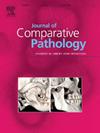Morphological changes in the nasal cavity of dogs and cats submitted to routine post-mortem examination: a systematic investigation
IF 0.9
4区 农林科学
Q4 PATHOLOGY
引用次数: 0
Abstract
Nasal cavity exploration is not a part of conventional necropsy, and systematic studies analysing histopathological changes in the upper respiratory tract of asymptomatic cats and dogs are scarce. This prospective study was carried out to evaluate the nasal cavity of all dogs and cats submitted to necropsy in a Brazilian veterinary anatomic pathology service from January to December 2023. Of 81 animals included (54 dogs and 27 cats), 67 (82.7 %) had one or more histological changes in the nasal cavity. Idiopathic lymphoplasmacytic rhinitis was the most common change in both species (45/67 [67.2 %]) and one dog with severe inflammation had secondary nasal conchae atrophy. In dogs, erosions and ulcers were the second most prevalent change (4/48 [8.3 %]), and two of these were secondary to uraemia. Oronasal fistulae were seen in two dogs (2/48 [4.2 %]). Neutrophilic rhinitis was the second most prevalent change in cats (5/19 [26.3 %]), one case being associated with Candida sp infection. Neoplastic changes were infrequent in both species (5/67 [7.4 %]). Systematically analysing the histological appearance of the nasal mucosa in presumably asymptomatic animals helps enlighten clinicians and pathologists on what to expect in nasal biopsy samples, assisting them in interpretation of the clinical significance of different lesions and improving the diagnosis of nasal cavity conditions of dogs and cats.
狗和猫的鼻腔形态学变化提交了常规尸检:系统的调查
鼻腔探查不是常规尸检的一部分,对无症状猫和狗上呼吸道组织病理学变化的系统分析研究很少。本前瞻性研究旨在评估巴西兽医解剖病理学服务机构于2023年1月至12月提交尸检的所有狗和猫的鼻腔。在纳入的81只动物(54只狗和27只猫)中,67只(82.7%)鼻腔有一种或多种组织学改变。特发性淋巴浆细胞性鼻炎是两种犬中最常见的变化(45/67[67.2%]),1只严重炎症的犬继发鼻甲萎缩。在狗中,腐蚀和溃疡是第二常见的变化(4/48[8.3%]),其中两种是继发于尿毒症。2只犬出现口鼻瘘(2/48[4.2%])。中性粒细胞性鼻炎是猫中第二常见的变化(5/19[26.3%]),其中一例与念珠菌感染有关。两种患者均未见肿瘤改变(5/67[7.4%])。系统分析无症状动物鼻黏膜的组织学外观,有助于启发临床医生和病理学家对鼻活检样本的期望,帮助他们解释不同病变的临床意义,提高对狗和猫鼻腔状况的诊断。
本文章由计算机程序翻译,如有差异,请以英文原文为准。
求助全文
约1分钟内获得全文
求助全文
来源期刊
CiteScore
1.60
自引率
0.00%
发文量
208
审稿时长
50 days
期刊介绍:
The Journal of Comparative Pathology is an International, English language, peer-reviewed journal which publishes full length articles, short papers and review articles of high scientific quality on all aspects of the pathology of the diseases of domesticated and other vertebrate animals.
Articles on human diseases are also included if they present features of special interest when viewed against the general background of vertebrate pathology.

 求助内容:
求助内容: 应助结果提醒方式:
应助结果提醒方式:


